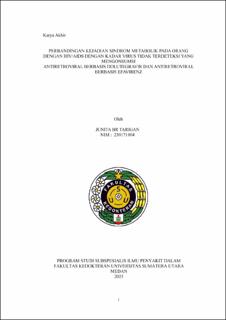| dc.description.abstract | Background: Metabolic syndrome is a condition consisting of central obesity,
elevated triglycerides, decreased HDL, hypertension, and hyperglycaemia, which
increase the risk of cardiovascular disease and type 2 diabetes mellitus. Long-term
use of antiretroviral therapy (ART) such as dolutegravir and efavirenz in people
living with HIV/AIDS (PLWHA), is suspected to contribute to an increased
incidence of metabolic syndrome.
Objective: To determine the difference in the incidence of metabolic syndrome
between PLWHA with undetectable viral loads who are using dolutegravir-based
and efavirenz-based ART.
Methods: A cross-sectional design study conducted from April to December 2024
at the PUSYANSUS Clinic, Haji Adam Malik Hospital, Medan. Samples were
obtained through consecutive sampling, There were 118 PLWHA met the inclusion
criteria, consisting of 40 individuals on dolutegravir and 78 individuals on
efavirenz. Data were collected through interviews, questionnaires, physical
examinations, and blood laboratory tests.
Results: Among a total of 118 PLWHA, predominantly of reproductive age,
metabolic syndrome was most indicated by hyperglycemia. No significant
difference was found between the use of dolutegravir and efavirenz in terms of the
overall incidence of metabolic syndrome. However, bivariate analysis showed that
dolutegravir use tended to increase the risk of obesity and decrease HDL level,
while efavirenz use was more associated with elevated blood pressure.
Conclusion: No significant difference between dolutegravir and efavirenz
concerning the incidence of metabolic syndrome in PLWHA with undetectable viral
loads. However, each regimen shows a tendency toward specific metabolic
symptoms.
Keywords: Metabolic syndrome, HIV/AIDS, antiretroviral, dolutegravir, efavirenz | en_US |


